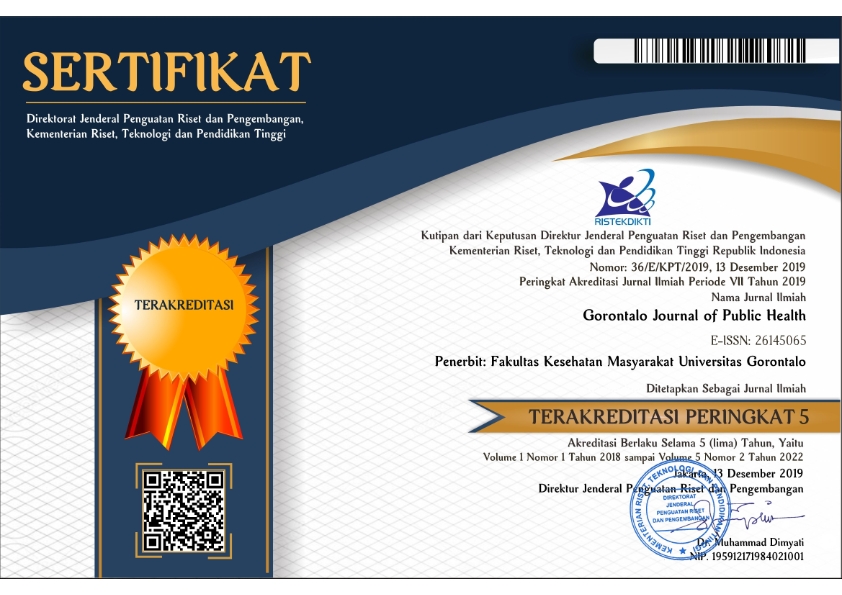Pengaruh Slow Stroke Back Massage terhadap Penurunan Depresi pada Pasien Pasca Stroke di RS. Harapan dan Doa Kota Bengkulu
Abstract
Stroke disease becomes a health problem and the main cause of disability that affects individuals and families. The condition of stroke patients in general can be recovered but with residual symptoms lasting 3-6 months even up to many years. The main factors that can inhibit healing in stroke patients are depression arising in post-stroke. The purpose of this research is to influence effects of slow stroke back massage toward decreasing depression of post-stroke patients in Poly Nerve RS. Harapan Dan Doa Bengkulu City, 2020. The research used quasi experimental with pre-test and post-test one group design. Total samples of 25 respondents consists of 1 group. The sampling technique used purposive sampling. The instrument used beck depression inventory II with 21 questions. The analysis used t-test at α <5%. The results showed that the mean value of depression before giving slow stroke back massage is 28.24 and after slow stroke back massage the average value of depression value is 22.40. There is an influence on the value of depression before and after the slow stroke back massage (p value = 0.000). Slow stroke back massage can decreasing depression of post-stroke patients in Poly Nerve RS. Harapan Dan Doa Bengkulu City.
Keywords
References
Aliabadi S. (2017). Sleep Quality and Its Contributing factors Among Elderly People: A Descriptive-Analytical Study. modern care journal, 14.
Asmawati, R. & N. (2013). Hubungan Usia dan Lamanya Menderita Stroke Dengan Kejadian Depresi Pasca Stroke di Poli Saraf RSU Mataram. Jurnal Kesehatan Prima, 3 No.1.
Institute for Health Metrics and Evaluation (IHME). (2017). Indonesian Life Expectation. http://www.healthdata.org/indonesia
Kemenkes RI. (2018). Riset Kesehatan Dasar; RISKESDAS. Balitbang Kemenkes RI.
Khomsiatun, Saparwati M., C. Z. (2015). Hubungan Status Fungsional Terhadap Depresi Pada Pasien Stroke di Ruang Fisioterapi di RSUD Wilayah Kabupaten Semarang. http://perpusnwu.web.id/karyailmiah/ documents/4844.pdf
Kring. (2009). PSIKOLOGI ABNORMAL. PT Raja Grafindo Persaja.
Lubis, N. L. (2010). Depresi Tinjauan Psikologis. Kencana Prenada Media Group.
Susilowati A., Ratep N, P. K. (2014). Depresi Pasca Stroke; Diagnosis Dan Tatalaksana Cermin Dunia Kedokteran. 41, 901–905.
Vika, W. N., Syarifah, A. S., & Ratnawati, M. (2018). HUBUNGAN STATUS FUNGSIONAL DENGAN TINGKAT DEPRESI PADA PASIEN STROKE DI RUANG FLAMBOYAN RSUD JOMBANG. Jurnal Ilmiah Kebidanan (Scientific Journal of Midwifery). https://doi.org/10.33023/jikeb.v4i1.156
Wardhani, I.O, & Santi, M. (2015). Hubungan Antara Karakteristik Pasien Stroke dan Dukungan Keluarga dengan Kepatuhan Menjalani Rehabilitasi. Jurnal Berkala Epidemiologi. 3, 24–34.
Wibowo, T. A. (2015). Slow Stroke Back Massage Terhadap Penurunan Depresi pada Penderita Pasca Stroke Iskemik. Jurnal Ilmiah Sehat Bebaya, 1 no. 2.
Wong, A. (2010). Neuropathology of pasca-stroke depression: Possible role of inlammatory molecules and indolamine 2,3 dioxygenase. //tspace.library.utoronto.ca/
World Health Organization (WHO). (2016). Stroke, Cerebrovascular accident. http://www.who.int/topics/cerebrovascular_accident/en/
Refbacks
- There are currently no refbacks.






